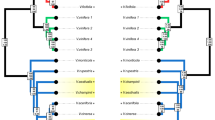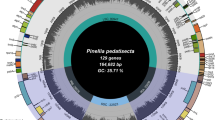Abstract
According to the neutral theory of evolution, mutation and genetic drift are the only forces that shape unconstrained, neutral, gene evolution. Thus, pseudogenes (which often evolve neutrally) provide opportunities to obtain direct estimates of mutation rates that are not biased by selection, and gene families comprising functional and pseudogene members provide useful material for both estimating neutral mutation rates and identifying sites that appear to be under positive or negative selection pressures. Conifers could be very useful for such analyses since they have large and complex genomes. There is evidence that pseudogenes make significant contributions to the size and complexity of gene families in pines, although few studies have examined the composition and evolution of gene families in conifers. In this work, I examine the complexity and rates of mutation of the phytochrome gene family in Pinus sylvestris and show that it includes not only functional genes but also pseudogenes. As expected, the functional PHYO does not appear to have evolved neutrally, while phytochrome pseudogenes show signs of unconstrained evolution.



Similar content being viewed by others
References
Ahuja MR, Neale DB (2005) Evolution of genome size in conifers. Silvae Genetica 54:126–137
Akashi H (1997) Distinguishing the effects of mutational biases and natural selection on DNA sequence variation. Genetics 147:1989–1991
Akashi H (1999) Synonymous codon usage in Drosophila melanogaster: natural selection and translational accuracy. Genetics 136:927–935
Aukerman MJ, Hirschfeld M, Wester L, Clack T, Amasino RM, Sharrock RA (1997) A deletion in the PHYD gene of the Arabidosis Wassilewskija ecotype defines a role for phytochrome D in far red/red light sensing. Plant Cell 9:1317–1326
Balakirev ES, Ayala FJ (2003) Pseudogenes: are they “junk” or functional DNA? Annu Rev Genet 37:123–151
Baldauf SL (2003) Phylogeny for the faint of heart: a tutorial. Trends Genet 19:345–351
Charlesworth B, Morgan MT, Charlesworth D (1993) The effect of deleterious mutations on neutral molecular variation. Genetics 134:1289–1303
Dvornyk V, Sirviö A, Mikkonen M, Savolainen O (2002) Low nucleotide diversity at the pal1 locus in the widely distributed Pinus sylvestris. Mol Biol Evol 19:179–188
Excoffier L, Smouse PE, Quattro JM (1992) Analysis of molecular variance inferred from metric distances among DNA haplotypes: application to human mitochondria DNA restriction data. Genetics 131:479–491
García-Gil MR, Mikkonen M, Savolainen O (2003) Nucleotide diversity at two phytochrome loci along a latitudinal cline in Pinus sylvestris. Mol Ecol 12:1195–1206
Gernandt DS, Liston A, Pineiro D (2001) Variation in the nrDNA ITS of Pinus cembroides: implications for molecular systematics studies of pine species complexes. Mol Phylogenet Evol 21:449–467
Higgins DG, Sharp PM (1988) CLUSTAL: a package for performing multiple sequence alignment on a microcomputer. Gene 73:237–244
Huelsenbeck JP, Ronquist F (2001) MRBAYES: bayesian inference of phylogenetic trees. Bioinformatics 17:754–755
Hughes AL (2000) Adaptive evolution of genes and genomes. Oxford University Press, New York
Kaplan NL, Hudson RR, Langley CH (1989) The hitchhiking effect revisited. Genetics 123:887–899
Kinlaw CS, Neale DB (1997) Complex gene families in pine genomes. Trends Plant Sci 2:356–359
Kvarnheden A, Albert VA, Engström P (1995) Molecular evolution of cdc2 pseudogenes in spruce (Picea). Plant Mol Biol 36:767–774
Li WH (1997) Molecular evolution. Sinauer Associates, Sunderland, MA
Li WH, Gojobori T, Mei M (1981) Pseudogenes as a paradigm of neutral evolution. Nature 292:237–239
Lynch M, Conery JS (2000) The evolutionary fate and consequences of duplicate genes. Science 290:1151–1155
Mathews S, Donoghue MJ (1999) The root of angiosperm phylogeny inferred from duplicate phytochrome genes. Science 286:947–950
McDonald JH, Kreitman M (1991) Adaptive evolution of the “Adh” locus in “Drosophila”. Nature 351:652–654
Mclnerney JO (2006) The causes of protein evolutionary rate variation. Trends Ecol Evol 21:230–232
Mighell AJ, Smith NR, Robinson PA, Markham AF (2000) Vertebrate pseudogenes. FEBS Lett 468:109–114
Miller CN (1977) Mesozoic conifers. Bot Rev 43:217–280
Murray BG (1998) Nuclear DNA amounts in gymnosperms. Ann Bot 82 (Suppl A):3–15
Neff MM, Fankhauser C, Chory J (2000) Light an indicator of time and place. Genes Dev 14:257–271
Nei M (1987) Molecular evolutionary genetics. Columbia University Press, New York
Nei M, Kumar S (2000) Molecular evolution and phylogenetics. Oxford University Press, New York
Nielsen R (2001) Statistical tests of selective neutrality in the age of genomics. Heredity 86:641–647
Petrov DA, Hartl DL (1999) Patterns of nucleotide substitution in Drosophila and mammalian genomes . Proc Natl Acad Sci USA 96:1475–1479
Petrov DA, Lozovskaya ER, Hartl DL (1996) High intrinsic rate of DNA loss in Drosophila. Nature 384:346–349
Petrov DA, Sangster TA, Johnston S, Hartl DL, Shaw KL (2000) Evidence of DNA loss as a determinant of genome size. Science 287:1060–1062
Reed DH, Nicholas AC, Stratton GE (2007) Genetic quality of individuals impacts population dynamics. Anim Conserv 10:275–283
Schubert R, Manteuffel R, Eich J, Häger KP (2002) Molecular characterization and evolution of the cytosolic class II 17.0 kDa small heat-shock protein gene family from Picea abies (L.). Plant Sci 163:1–12
Skinner JS, Timko MP (1998). Loblolly pine (Pinus taeda L) contains multiple expressed genes encoding light-dependent NADPH:protochlorophyllide oxidoreductase (POR). Plant Cell Physiol 39:795–806
Suzuki Y, Gojobori T (1999) A method for detecting positive selection at single amino acid sites. Mol Biol Evol 16:1315–1328
Swanson WJ (2003) Adaptive evolution of genes and gene families. Curr Opin Genet Dev 13:617–622
Wakasugi T, Tsudzuki J, Nakashima K, Tsudzuki T, Sugiura M (1994) Loss of all Ndh genes as determined by sequencing the entire chloroplast genome of the black pine Pinus thumbergii. Proc Natl Acad Sci USA 91:9794–9798
Watterson GA (1983) On the time for gene silencing at duplicated loci. Genetics 105:745–766
Wei XX, Wang XQ (2004) Recolonization and radiation in Larix (Pinaceae): evidence from nuclear ribosomal DNA paralogues. Mol Ecol 13:3115–3123
Wright S (1969) Evolution and the genetics of populations, vol 2. The theory of gene frequencies. University of Chicago Press, Chicago
Wright F (1986) The “effective number of codons” used in a gene. Gene 87:23–29
Wyckoff GJ, Malcom CM, Vallender EJ, Lahn BT (2005) A highly unexpected strong correlation between fixation probability of nonsynonymous mutations and mutation rate. Trends Genet 21:381–385
Xia X (1996) Maximizing transcription efficiency causes codon usage bias. Genetics 144:1309–1320
Xia X (2001) Data analysis in molecular biology and evolution. Kluwer Academic, New York
Yang Z, Bielawski JP (2000) Statistical methods for detecting molecular adaptation. TREE 15:496–503
Acknowledgments
I thank Professor Outi Savolainen for useful comments on the manuscript, and I gratefully acknowledge the financial support from the European Science Foundation grant and the Marie Curie fellowship (QLK5-CT-2000-51233) provided under the 5th Framework Programme and Bioscience and Environmental Research Council.
Author information
Authors and Affiliations
Corresponding author
Rights and permissions
About this article
Cite this article
García-Gil, M.R. Evolutionary Aspects of Functional and Pseudogene Members of the Phytochrome Gene Family in Scots Pine. J Mol Evol 67, 222–232 (2008). https://doi.org/10.1007/s00239-008-9135-z
Received:
Revised:
Accepted:
Published:
Issue Date:
DOI: https://doi.org/10.1007/s00239-008-9135-z




